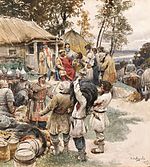Drevlians

The Drevlians (Деревляни, Derevliany in Ukrainian; Древляне, Drevlyane in Russian) were a tribe of Early East Slavs between the 6th and the 10th century, which inhabited the territories of Polesia and Right-bank Ukraine, west of the eastern Polans and down the stream of the rivers Teteriv, Uzh, Ubort, and Stviga. To the West, the Drevlians' territories reached the Sluch River, where the Volynians (related to the territory of Volynia) and Buzhans (related to the name of Southern Bug river) lived. To the North, the Drevlians' neighbors were the Dregovichs.

The name of the tribe derives from the Slavic word древо or дерево (drevo, or derevo), which means "tree", because the Drevlians used to live in thick woods.
The Drevlians left many archaeological traces, such as agricultural settlements with semi-dugouts (or earth-houses), moundless burial grounds and barrows, fortified towns like Vruchiy (today's Ovruch), Gorodsk, site of an ancient settlement near Malyn (supposedly, a residence of the Drevlian prince Mal) and others. The principal city of the Drevlians was Iskorosten (today’s Korosten), where one can still see a group of compact ancient settlements. After they were conquered by the Kievan Rus', Iskorosten was burned to the ground and the capital was transferred to Ovruch.[1] By the end of the first millennium, the Drevlians already had well-developed farming and handicrafts.
The Drevlians opposed fervently any attempts by outsiders to include them in Kievan Rus. According to a number of chronicles, in the times of Kyi, Schek and Khoriv (supposedly, founders of Kiev) the Drevlians had their own princely rule and were frequently at war with the Polans. In 883, Prince Oleg of Novgorod made the Drevlians pay tribute to Kiev. In 907, the Drevlians took part in the Kievan military campaign against the Byzantine Empire.

After Oleg’s death in 912, the Drevlians stopped paying tribute. The Varangian warlord Sveneld made them pay tribute to himself. Oleg's successor Igor attempted to levy the tribute after Sveneld, but the Drevlians revolted and killed him in 945. Igor’s widow Olga avenged her husband’s death in an extremely harsh manner, killing Drevlianian ambassadors and nobility, burning their capital of Iskorosten to the ground and leveling other towns. After having subjugated the Drevlians, Olga transformed their territories into a Kievan appanage with the center in Vruchiy.

The last mention of the Drevlians was in a chronicle of 1136, when their lands were given as a gift to the Church of the Tithes by Yaropolk Vladimirovich.
See also
References
- ^ Mykhailo Hrushevsky. History of Ukraine-Rus.
- Wixman. The Peoples of the USSR, p. 59
